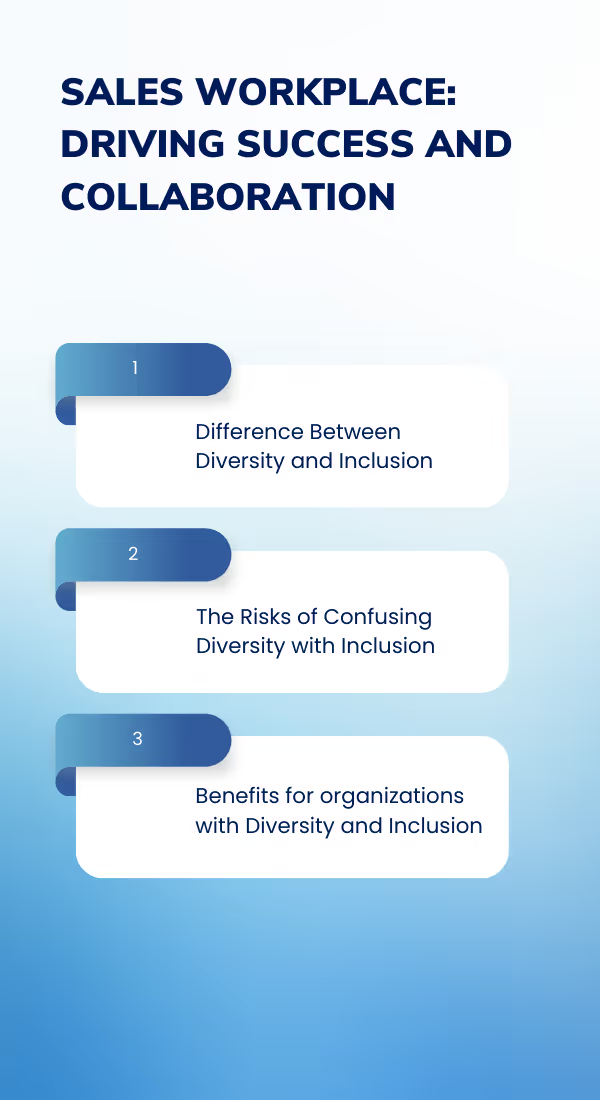
Blog
Sales Workplace: Driving Success and Collaboration
July 22, 2022


Key Insights
One concept that has gained momentum in the corporate world of late is Diversity and inclusion, also known as D&I. All major companies across the globe are incorporating D&I policies at all workforce levels to become diverse.
The way companies do business now and how they used to do it over the past decades has changed both politically and socially. This has resulted in leading companies taking steps to increase equity, diversity, and inclusion. Most companies think making company D&I is a matter of ethics. Contrary to this belief, making a company diverse and inclusive is much more than a matter of ethics. It also drives the force of revenue, growth, and profit.
Diversity and inclusion (D&I) are more than programs, policies, or headcounts. Businesses outpace their competitors by acknowledging and respecting the perspectives, potential, and unique needs of all their employees, including those involved in the sales recruitment process..It is because of this reason, diverse and inclusive workplaces receive more commitment and deeper trust from their employees. One of the key workplace trends in 2020 was workplace diversity. The pandemic caused by Covid-19 forced companies to work as a global workforce. As a result, many companies started hiring more and more diverse teams while working remotely.

What are Diversity and Inclusion?
Diversity and Inclusion refer to the set of policies, strategies, and missions a company adopts to create and encourage an inclusive workplace that helps them attract a pool of talent from various cultural backgrounds.
D&I acts as a business advantage to the companies. Companies that have D&I practices and policies are more creative and supportive of different voices. It helps them attract top talent from the industry. Here they are clubbed together but diversity and inclusion are two different terms.
Diversity in the workplace refers to a company’s workforce composed of people from different genders, ethnicities, religions, sexual orientations, races, ages, etc. Lori George Billingsley, Chief Diversity Officer for the Coca-Cola Company defines diversity as “the differences you can see or describe in people.”
Inclusion in a company’s workplace means the company ensures that every employee feels included and a part of the team. An inclusive workforce will feel seen, valued, heard, and respected. Because of Inclusion, you will notice higher cooperation, a boom in innovation, and increased employee engagement, which can positively impact sales cycle length.
Difference Between Diversity and Inclusion
The 2018 Gallup Report said that if an organization has to start creating D&I, the first step is acknowledging the fact that diversity and inclusion are two different concepts.
Companies must not confuse the two terms. Both the terms are not synonymous and hence it is important to know the difference between the two
According to an article in Harvard Business Review , “when it comes to the workplace, diversity equals representation, without inclusion, it would be difficult to attract diverse talent, encourage participation, foster innovation, and grow the business”

The Risks of Confusing Diversity with Inclusion
Workplace diversity and inclusion is a very broad topic to cover in a single article. It covers many themes like leadership, discrimination, unconscious bias, and groups like women, men, veterans, people of color, people with disabilities, LGBT professionals. If a company confuses diversity for inclusion, there is a high chance it will lead to ill consequences. Below are some of the consequences for the same:
- A company risks the psychological safety of their valuable employees if they don’t have an inclusive approach in their place. If psychological safety is missing, employee engagement will be almost zero, and they will hardly succeed professionally.
- A lot of companies integrate D&I policies into their work culture not only for ethical reasons but also to increase business profitability. When you compromise inclusion at your workplace, the employees will feel reluctant to participate in the decision-making process actively. This will have an adverse effect on the performance of your business.
- You may hire a diverse workforce but if you fail to make them feel included, it will not serve the purpose. With time, the negative feelings towards the company and sense of alienation will take hold. In such a scenario, the diversity policies might backfire on you if not balanced well with inclusion policies.
How to Improve Diversity and Inclusion at your Sales workplace?
As per the US Bureau of Labor Statistics estimates more than 38 million people will enter the labor force between 2016 and 2026. During this decade, the composition of the labor force will become racially and ethnically diverse and also older. Companies across the world are coming up with initiatives to remove barriers and combat biases to ensure marginalized and underrepresented groups get what others are having.
Here are some of the ways by which managers, HR executives, and business leaders can improve diversity and inclusion in the workplace:
- Lead By Example: As a leader, you should ask yourself questions such as “Is my team of executives diversified? Are men and women equally represented in my team of managers and executives? Do I have a fair representation of people from various religions and cultures among senior executives?” It’s also not about the numbers and representations.You need to take an additional step and understand, recognize, and curb biases and prejudices that contradict the culture. This is particularly crucial in roles like field sales vs inside sales, where diverse perspectives can enhance problem-solving.. For this reason training and educating leaders to come in. Pharmaceutical giant Merck & co. Inc. for example, organizes regular training in unconscious bias for managers and executives at all levels. Such training help leaders to recognize discrimination in the team and its impact on the affected individuals and the entire workforce.
- Make the Workplace Inclusive: How inclusive is your workplace? You should figure out if you have implemented the policies does it reflect at ground zero? Do you honor multiple religious and cultural practices? If not, the first step you can take is to acknowledge these differences. Once done you can integrate them into your workflow and structure. For example, do your Hindu employees feel included in holidays and office parties? Or are your workplace celebrations just focused on traditional Christian events, such as Christmas and Easter? To ensure inclusion and fair treatment of a diverse workforce, you must understand their perspectives and must identify their unique needs. You can do so by conducting a regular comprehensive evaluation of your company’s demographics and the unique needs of various employee groups.
- Integrate Diversity and Inclusion into Evaluation, Recruitment, and Performance Management: The research on the hiring process suggests that the process is full of bias. Although in most cases it is not done intentionally. Much of it stems from unconscious racism, sexism, and other forms of discrimination. A hiring manager can unconsciously reflect their own bias in the recruitment process that can impact the company’s success in the long run. You can stop this from happening in your company by creating an inclusive council. The council should have influential leaders who have dedication and passion and for driving and upholding an organizational philosophy centered on diversity and inclusion. Just ensure the council is also diverse else it defeats the purpose of pushing an inclusive culture.
- Reconsider Your Brand: Culture and brand are always intimately connected. The products and services you put into the market reflect your values and also your biases. When you start on your journey of building an inclusive organization, it’s important you consider the relationship between what’s happening inside and outside your company. You should answer questions such as - What is your brand saying about who you are as a culture? What experiences are being left out or misunderstood in the company?
Benefits for organizations with Diversity and Inclusion
Research over the past decade has shown many benefits of a diverse and inclusive workplace. Below are the top three benefits, and utilizing tools like a saas commission calculator can further enhance these advantages:
- Increase in growth revenue
- Greater readiness to innovate
- Increased ability to hire a diverse talent pool
The research also tells when employees trust that they, and their colleagues, will be treated fairly regardless of their sexual orientation, race, gender, or age, they are:
- 9.8 times more likely to look forward to going to work
- 6.3 times more likely to have pride in their work
- 5.4 times more likely to stay a long time at their company
- 5.4 times higher employee retention
Cultural diversity in the workplace leads to an increase in creativity among teams, and the ability to come up with a more diverse set of solutions to specific problems.
In a recent article, the writer points out “It has been proved that when individuals are exposed to experiences with multiple perspectives and worldviews, their potential to remain consistent with creativity and innovation improves. The cocktail of various perspectives in their respective novel ways result in new ideas “popping up.”
Wrapping Up
In this competitive business world, companies that remain “for some” workplaces will earn less, risk losing money and may fall behind their competitors. On the other hand, companies that succeed with D&I will cultivate tremendous value from their employee's differences and will excel.
ReKennect : Stay ahead of the curve!
Subscribe to our bi-weekly newsletter packed with latest trends and insights on incentives.
Thank you! Your submission has been received!
Oops! Something went wrong while submitting the form.
Your data is in safe hands. Check out our Privacy policy for more info
















